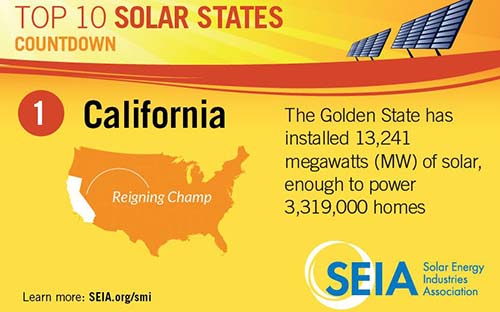 Loading... Please wait...
Loading... Please wait...Products
- Solar Panels
- Solar Panel Kits
- Solar Generators
- Inverters
- Inverter Monitoring
- Inverter Accessories
- Balance of Systems
- Racking and Mounting
- Rails
- Flashings
- Splice Kits
- Stopper Sleeves
- Conduit Mounts
- Attachments
- Brace Assembly
- Base Mount
- Brackets
- Bolts
- Clamps
- Caps
- L-Feet
- Washers
- Skirt
- Lugs
- Tilt Legs
- Hooks
- Stand-Offs
- Ballast Bay
- Top of Pole Mount
- Side of Pole Mount
- Flush Mount Kits
- Ground Mount Kits
- Roof Mount Kits
- Hardware Packages
- Wire Management
- Batteries
- Battery Accessories
- Charge Controllers
- Tools and Supplies
- View All Products
Solaris Blog - Calforina Solar Rebates
California Solar Energy Incentives List
Posted by Brandi Casey on 26th Feb 2017

California has long been a leader in renewable energy
installations and incentives for both businesses and homeowners. The state’s
Renewable Portfolio Standard currently requires all utilities to source 33
percent of their electricity generation from a renewable energy source by the
year 2020. California further offers a popular residential power-purchase
agreement/leases, that allow third-parties to own the solar array and provide
the home or building owner with a fixed price for the system or the electricity
it produces over the lifetime of the contract. Typically, this contract can
range from 10 to 25 years. California further incentivizes home owners by
offering a net-metering option in which homeowners can sell their excess
electricity their solar system produces back to the power company. In addition
to the Federal Tax incentive, California offers reimbursement for the cost of
the purchased components and installation through the California Solar Initiative.
California Solar Power Financial Incentives
|
Green Building Incentives: |
|
|
Leasing/Lease Purchase: |
|
|
Local Grant Program: |
|
|
Local Loan Program: |
|
|
Local Rebate Program: |
|
|
Production Incentive: |
|
|
Property Tax Exemption: |
|
|
State Grant Program: |
|
|
State Loan Program: |
|
|
State Rebate Program: |
|
|
Utility Grand Program: |
|
|
Utility Loan Program: |
|
|
Utility Rebate Program: |
|
In addition to their impressive list of financial incentives. California also has a number of rules and regulations that homeowners should keep in mind. Careful planning is highly important to any solar installation, and a trip to your local municipalities will be worth your while prior to purchase. You may also find out that your future system is eligible for more incentives and rebates than what is listed above. Regulations vary from county to county, so installers should be aware of what the regulations are in the particular county they are working in. If you are looking for an installer, start first with an installer that is listed in your county. If there is not an installer available, then ask the installers you speak with about their knowledge of regulations in your area. Knowledge of regulations prior to installation can save a great deal of time, money and ensure that your installation goes as smoothly as possible. Be sure to address any concerns that arise during the solar permit process.
Rules, Regulations and Policies
|
Appliance / Equipment Efficiency Standards: |
|
|
Building Energy Code: |
|
|
Contractor Licensing: |
|
|
Energy Standards for Public Buildings: |
|
|
Generation Disclosure: |
|
|
Green Power Purchasing / Aggregation: |
|
| Interconnection: |
|
|
Net Metering: |
|
|
Public Benefits Fund: |
|
|
Renewables Portfolio Standard: |
|
|
Solar Access Law / Guideline: |
|
| Solar / Wind Permitting Standards: |
|
Residents and businesses in California have a number of solar energy incentives to choose from. Through careful planning and execution, it is possible to increase both your energy efficiency and find the best ROI for your area. Obtaining solar permits is the first step in the process, and one that we at Solaris can assist you with, to find out more check out our Solar Energy Services. We can also assist in designing your energy system to meet and exceed energy standards. You can also view our pre-designed solar energy systems.



